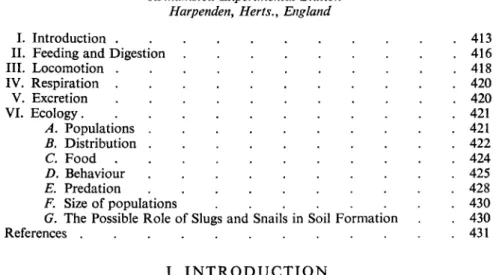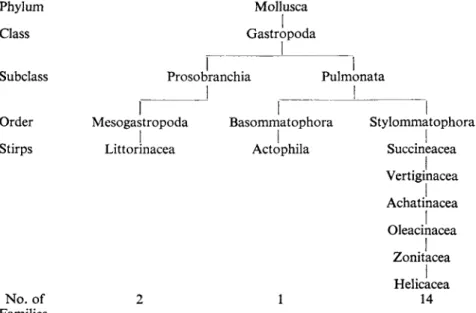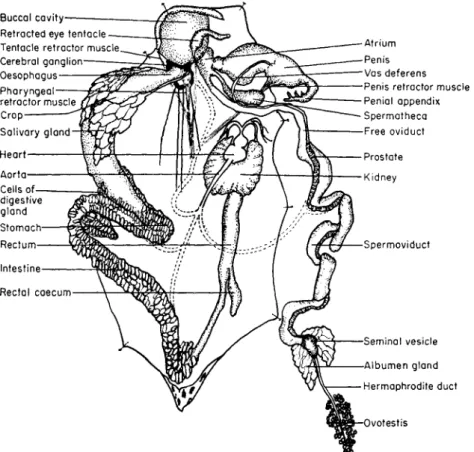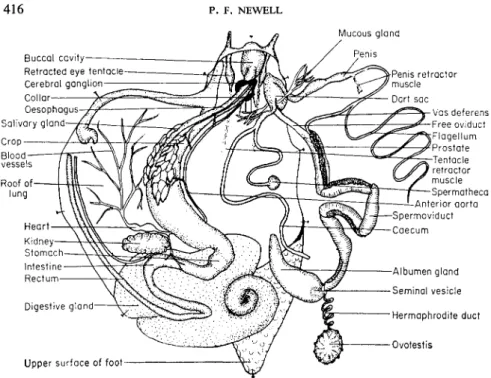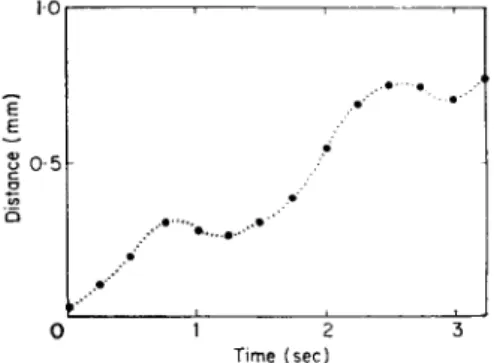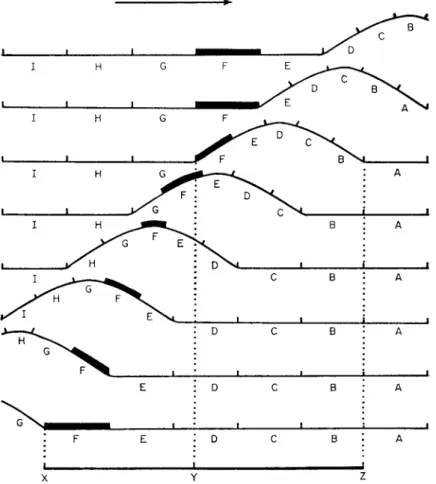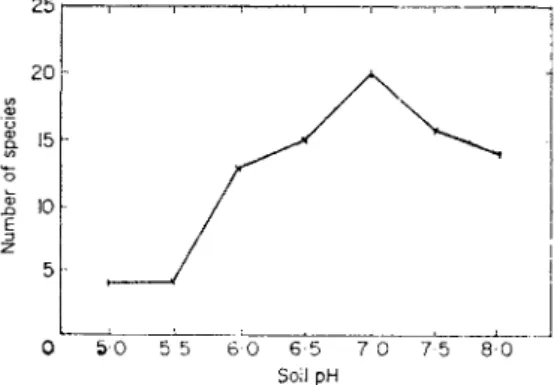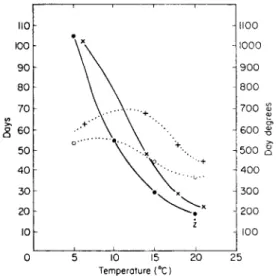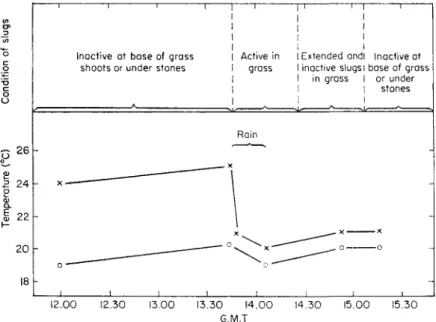Chapter 13
Mollusca
P. F. NEWELL
Rothamsted Experimental Station*
Harpenden, Herts., England
I. Introduction 413 II. Feeding and Digestion 416
III. Locomotion 418 IV. Respiration 420
V. Excretion 420 VI. Ecology 421
A. Populations 421 B. Distribution 422 C. Food 424 D. Behaviour 425 E. Prédation 428 F. Size of populations 430
G. The Possible Role of Slugs and Snails in Soil Formation 430
References . . . 431
I. I N T R O D U C T I O N
Some representatives of most of the major phyla of marine animals, including Mollusca, succeeded in colonizing the land, often it is believed, via freshwater. There are many terrestrial species of molluscs and some are abun- dant, but their diversity is small compared with the marine forms; conse- quently most standard works (see References) deal mainly with marine molluscs. This account summarizes the salient features of the biology of terrestrial snails and slugs with the emphasis on their ecology.
The nomenclature of snails and slugs has often been revised. For uniformity Ellis's nomenclature in the 1951 census of British non-marine Mollusca has mostly been used for snails and Quick's (1960) for slugs. However, Cepaea nemoralis (L.) is used in preference to the name Helix nemoralis, and Agrioli- max agrestis (L.) has been changed to A. reticulatus (Müller) because A.
agrestis has been definitely recorded only from Norfolk. The generic name Agriolimax has been used in preference to Deroceras, which appears in the American literature.
Figure 1 relates the number of terrestrial families of Mollusca in the 1951 British census to Thiele's stirps or super-families (Thiele, 1931-35), and shows that most British terrestrial families belong to the stylommatophoran group
* Now at Westfield College, University of London, England.
414 P. F. NEWELL
of pulmonates. Many of the modifications to the basic marine molluscan pattern they show are associated with the transition to land and include the development of a lung, internal fertilization, large yolky eggs and various physiological and behavioural methods of water conservation; these are features that also occur in many littoral gastropods.
Morton (1955, 1958), reviewing the origins and evolution of the pulmo- nates, reaffirmed the view that those unspeciahzed Basommatophora, the Ellobiidae and Chilinidae, are the most primitive families and share many features with an ancestral group of pulmonates from which terrestrial Stylommatophora could have arisen.
Phylum Class
Subclass
Order Stirps
No. of
Prosob
1
1 1
Mesogastropoda
1 1 Littorinacea
2
Mollusca
1
Gastropoda
| _ _
ranchia
1
Pulmonata
1 1
Basommatophora Actophila 1
1
Stylommatophora
1
1 1 Succineacea Vertiginacea
1
Achatinacea
1
Oleacinacea
1
Zonitacea
1
1
Helicacea 1 Families 14
FIG. 1. An outline classification of British land mollusca based on Thiele, 1931-1935.
Number of families taken from Ellis, 1951.
Of the non-pulmonate (operculate or prosobranch) land snails only Pomatias elegans (Müller) and Acme fusca (Montagu) occur in the British Isles, but in some tropical areas, such as Jamaica, about half of all species present on the island are operculate snails (Hunter, 1955). These operculate snails are thought to have been derived from marine snails similar to peri- winkles (Littorinidae) which they closely resemble.
There are two main groups of land pulmonates, namely, snails and slugs, and there can be little doubt that slugs have been derived from fully-shelled pulmonates, perhaps along two distinct lines. The families Testacellidae and Limacidae, which include all slugs with a reduced external or internal shell, have probably been derived from a group of snails with reduced, thin shells similar to the Glass-snails, Hyalinia sp. The Arionidae include slugs with no
true shells and are thought to have been derived from a group of snails, similar to Helix, by the complete loss of the shell.
Most snails and slugs can be identified from external characters and often, as with snails, by their shells alone, though sometimes colours and texture of shells alter with age and weathering, and some species have many colour varieties (Cain and Williamson, 1958). Some species have to be identified by
Buccal cavity ■—
Retracted eye tentacle Tentacle retractor muscle Cerebral ganglion Oesophagus Pharyngeal retractor muscle Crop
Salivary gland Heart Aorta- Cells of- digestive gland Stomach- Rectum Intestine Rectal caecum
Atrium Penis Vas deferens Penis retractor muscle Penial appendix Spermatheca Free oviduct Prostate Kidney
Spermoviduct
Seminal vesicle Albumen gland Hermaphrodite duct
votestis
FIG. 2. General anatomy of a slug, Agriolimax reticulatus, with the animal dissected so that the mantle lies to the right. The blood vascular system is not shown but dotted lines indicate the sites that the main branches supply. The genitalia, and particularly the shape of the atrium, penis and penial appendix are most important features for their identification.
dissection of the genitalia. Many snails live in well-defined habitats; the plants in the area and the precise locality of collection are often valuable aids to identification. Ellis (1926) gives keys for identifying most British snails and slugs, Morton and Machin (1959) give a field key to common British snails and Barnes and Weil (1944) give one for slugs. Quick's "British Slugs"
(1960) is an excellent specialist's book for identifying slugs. Figures 2 and 3 show the general anatomy of a slug and a snail.
15*
416 P. F. NEWELL
FIG. 3. General anatomy of a snail, Helix aspersa, with the animal dissected so that the mantle lies to the left.
II. F E E D I N G A N D D I G E S T I O N
The structures associated with feeding of land gastropods all show a common pattern. They consist of a radula and a jaw embedded in the walls of the anterior end of the alimentary canal, the buccal cavity. The radula is a strip of tough membrane covered with teeth, rather like a wood rasp, which are continuously being replaced at the posterior end. This rasp is worked to and fro over a bar of hard tissue, the odontophore, which supports it as it tears away small pieces of the material on which the animal feeds. The shape and number of the radula teeth vary greatly between différent genera but usually carnivorous species, such as Testacella slugs, have relatively few, long teeth whereas typical herbivorous browsers, such as Helix aspersa Müller, have many, small, regularly arranged ones. Most species have a single chitinized mandible, or jaw, embedded in the upper portion of the anterior end of the buccal cavity.
The small particles of food, scraped off by the radula, are passed into the gut where digestive enzymes secreted by the digestive gland act on them.
There are at least 30 enzymes in the gut-extracts of Helix pomatia L. and H.
aspersa, of which two-thirds are carbohydrases (Holden, Pirie and Tracey, 1950; Holden and Tracey, 1950). Both lipases and proteinases are present in small amounts. Most of a minced and washed tobacco leaf lamina
preparation was digested by these enzymes leaving a residue of cuticle, vessels and chlorenchyma sludge.
Myers and Northcote (1958) reported abundant carbohydrases and "sig- nificant lipase activity" but little proteinase activity in gut extracts of H.
pomatia. Undoubtedly most of these enzymes come from the hepatopancreas, or digestive gland, of the snail, but there has been much controversy about the source of cellulase and chitinase enzymes.
Cellulose digesting bacteria in the gut of ruminants do not produce a free cellulose; the enzyme is bound to the surface of the bacteria (Kitts and Underkofler, 1954). Gut extracts of snails contain a free cellulase whose activity does not alter with storage (Holden and Tracey, 1950). This suggests that if bacteria are responsible for the free cellulase in gut extracts they cease to produce enzymes when isolated; moreover, as the cellulase activity was unaltered by centrifuging the extracts to remove bacteria the cellulase was probably secreted by the hepatopancreas of the snail. Strasdine and Whitaker (1963) later showed that the hepatopancreas of H. pomatia contained only few bacteria and that after the snail emerged from hibernation its protein content decreased greatly while enzymatic protein in the gut juice in the form of cellulase and chitinase increased (Table I); thus supporting the view expressed above. Tribby and Carmichael (1935) demonstrated a cellulase in gut extracts of the slug Limaxflavus, L.
TABLE I
Properties of digestive juice homogenates of hepatopancreas and intestine from hibernating snails (A) and feeding snails (B) (Strasdine
and Whitaker, 1963)
Average values/snail Specific activity
Protein Cellulase Chitinase Cellulase Chitinase Cellulase/
(mg) units units units/mg units/mg chitinase protein protein ratio Digestive juice
Hepatopancreas Intestine
Strasdine and Whitaker (1963) also found that when snails were fed briefly after emergence from hibernation, and then starved for 5 days the volume of their digestive juice increased and had almost the same concen- tration of protein, cellulase and chitinase as the smaller quantity of juice produced by snails starved only for one day (Table II).
This again conflicts with the idea that the cellulase and chitinase came solely from bacteria which are unlikely to produce it in the same amounts per unit
A B A B A B
206 122 160 95 8-2 11-4
320 541 49-6 45-2 9-2 13-3
10-2 15-7 1-5 1-6 0-25 0-40
2-63 2-63 0-31 0-47 1-12 117
0084 0076 0010 0016 0030 0032
31 34 31 30 37 37
4 1 8 P. F. NEWELL
volume of extract in starved and unstarved snails, and the fact that the hepato- pancreas lost protein suggests the enzymes were produced there.
However, two types of cellulose-digesting bacteria occur in the gut of H.
pomatia (Florkin and Lozet. 1949), so probably snails digest cellulose by cellulases from the bacteria in the gut as well as by their own cellulases.
TABLE II
Properties of digestive juice of snails deprived of food after a brief post-hibernation feeding* (Strasdine and Whitaker, 1963)
Mean concentration
Period Mean Protein Helicorubin Cellulase Chitinase Mean ratio, without volume mg/ml units/ml units/ml units/ml cellulase/
food (days) (ml) chitinase 1 0-42±005 267±15 67-3±8-5f 981±82 24-2±l-9t 38·8±3·3
2 0·58±0·05 221± 15 66·6±9·2 784±82 22·2±1·6 35·1±2·8 3 0-65±005 241 ±15 71*9±5-5 890±82 23·2±1·6 38·4±2·8 Combined averages 243±9 68·6±3·8 885±47 23-1 ±1-0 37·3±1·7
* The body weights of the snails were adjusted to 15-3 g.
t Mean and standard error estimate of 3 samples; all other averages estimated from 4 samples.
III. L O C O M O T I O N
Slugs and snails crawl by muscular waves, which appear like a series of dark bands and pass from back to front on the lower surface of the foot.
These dark bands correspond to contracted areas of the foot not in contact with the substrate; the wider, lighter, areas are in contact with the surface.
Lissmann (1945) gives a very clear account of the crawling mechanism in H. aspersa and H. pomatia. Any one point on the anterior end of the foot
Time (sec)
FIG. 4. Forward motion of mucous glands on the sole of the foot of Helix pomatia, normal crawling vertically upwards. (Redrawn from Lissmann, 1945.)
moves at an irregular speed. The distance moved by any easily identifiable point on the snail's foot, such as a large mucous gland, plotted against unit time shows only a short interval when any point is stationary, and forward
Direction of movement
FIG. 5. Diagram showing lifting, contraction and expansion of a portion of the foot of Helix during the passage of a pedal wave. (Redrawn from Lissmann, 1945.)
A given part, section F, is overtaken from the rear by a pedal wave. It is then lifted, contracted and carried forward and makes contact with the surface in a position anterior to that which it formally occupied. The distance moved forward by the passage of any wave is represented by the line XY and is the difference in length between the contracted portion, YZ, and the uncontracted portion, XZ.
movement continues after the wave has passed (Fig. 4). The animal loses some forward motion which is greatly exaggerated when it is crawling vertically on a well-lubricated surface. Figure 5 shows the vertical displacement and for- ward movement of a fixed point when a wave passes through.
420 P. F. NEWELL
All gastropods have many mucous glands in the foot which lubricate its surface as it moves across the ground, leaving dried trails as evidence of snail and slug activity. A few land snails are peculiar in that they progress not by waves of contraction along the foot, but by cilia beating in the secreted mucous. Elves (1961) described this for Discus rotundatus (Müller): most of the species crawling in this way are small and live in moist places, e.g. Acme fusca and Zonitoides nitidus (Müller).
IV. RESPIRATION
Land pulmonates respire through all the skin, but especially through the walls of the mantle cavity, most of which is specialized to form a lung.
With shell-less animals, such as slugs, or with shelled molluscs extended, the role of the skin as a respiratory surface is often underestimated. Pelseneer (1935), however, did not doubt the respiratory functions of the skin and quotes Schuurmans Stekhoven (1920), who found that when the mantle cavity of the slug Agriolimax agrestis (Limax agrestis in his paper) is filled with paraffin wax, respiration continues, but only at 43-80% of the former rate.
Recently Machin (1962) investigated the blood supply to the foot and mantle of the snails Helix aspersa and H. pomatia; the whole of the body, but especially the foot, mantle, pedal mucous gland and nervous system, is well supplied with numerous thin arteries. This is contrary to the usual concept of an "open" blood circulation system where the blood seeps into the tissues from the haemocoel.
Thus, as the moist skin is well supplied with large quantities of blood and blocking the mantle cavity is not lethal; it seems likely that, although a large part of the total gaseous exchange occurs through the walls of the mantle cavity, a significant amount also occurs through the moist skin. The Vagenu- lidae, found in tropical America, and the Oncidiidae, found near the high tide mark on the Cornish or south Devon coasts (Ellis, 1926) have no mantle cavity, are sluglike, and respire solely through the moist skin.
V. EXCRETION
The nitrogenous waste products of metabolism are excreted, in a solid form, as insoluble uric acid, in a manner comparable to that of birds and reptiles. All land gastropods have a single kidney that filters the nitrogenous waste from the blood in the pericardium and opens externally by a short duct, near the anus in pulmonates and to the rear of the mantle cavity in proso- branchs. Pericardial glands, developed from the thickened pericardial epithelium, are accessory excretory organs. The kidney resorbs water and some inorganic salts and excretes the uric acid via the kidney duct to the out- side. Urine formation in pulmonate molluscs has recently been studied by Martin, Stewart and Harrison (1965).
VI. E C O L O G Y
A. POPULATIONS
Methods of assessing populations are easiest for those molluscs that occur on the surface of the soil, for which random quadrats can often be used.
However, as mentioned earlier, molluscs are extremely sensitive to micro- environmental conditions and usually aggregate. For example, Helix aspersa will be found in crevices and under some large stones, Cepaea nemoralis often on the stems of stinging nettles (Urtica dioca L.) and the stems of hogweed (Heracleum sp.). These animals will sometimes become active after rain and crawl over vegetation. Counting the numbers in a square yard or the numbers collected after dark (Barnes, 1944) may not then give a true estimate of the total population, but only of those active on the surface. Similarly, the num- bers of slugs caught in metaldehyde traps in the field depends on the activity of the animals (Thomas, 1944). Webley (1964) recently showed that the num- bers of slugs caught by this type of trap is related to the average night tem- perature and the age of the bait; most slugs are caught on a warm night with a fresh bait. Such difficulties have dogged population studies of slugs.
Other soil animals are sampled by taking soil cores with a standard sampling tool to a known depth, extracting them by flotation or by a Tiillgren funnel. Such extraction methods are impracticable for routine estimation of slug populations which are usually small compared with those of soil arthro- pods and may be aggregated (South 1965) and so give variable results. Taking larger soil samples greatly increases the labour of sampling. Separating slugs from soil by hand is inefficient and time-consuming (Bruel and Moens, 1958), and a flotation technique has recently been devised by South (1964).
Another method of estimating populations is to release a known number of marked animals onto a known area and then to calculate the total population by the proportion of marked slugs recaptured (Lincoln, 1930; Jackson, 1939).
The population present at the time of sampling is given by the equation, axe
p=—
where p = population present, a = number released, b = number recaptured and c=number of unmarked captures.
This technique is easy with snails whose shells can be painted different colours with a quick-drying cellulose acetate paint, but slugs cannot be marked in this way because of their slimy skin. However, they can be labelled by feeding them on lettuce plants grown in a solution containing the radioactive isotope of phosphorus, 32P, so that the plants contain about 4 μθ of 32P (Newell, 1963). These marked animals are then randomly released into the field (they remain identifiable for at least 1 month), and a series of random samples of the population are made at regular intervals. Assuming that marked and unmarked slugs are equally likely to be captured, the field population can be calculated. Modern refinements of the release and recap- ture technique depend on marking individuals each time they are captured
422 P. F. NE WELL
thus allowing emigration, immigration, birth and death rates to be estimated.
At present this method is useful only for assessing population sizes, because individuals that have been recaptured only once cannot be distinguished from those that have been recaptured many times. Other radioactive isotopes were used as markers by Moens et al (1965).
Trapping techniques for estimating populations of all land gastropods are probably the easiest to use on a large scale. However, before they can give precise estimates the relationship between the actual populations, the pro- portion active during any trapping period and the trapping efficiency must be established. Recent work at Rothamsted shows that, in July, most A. reticu- latus slugs in an outdoor microplot are active on the surface during warm nights.
B. DISTRIBUTION
When collecting snails or slugs in the field it is soon noticed that some sites contain more species, and individuals, than others. Boycott (1934), in his classical paper on the habitats of British land mollusca, considers that lime and moisture are the co-dominant ecological factors that determine distribu- tion. Earlier, Atkins and Lebour (1923) observed that many more species, and individuals, occur in soils with higher pH values with more available calcium than in the more acid soils (Fig. 6). They also noticed that those
25
20
(Λ 0)
Ό g 15 Ü 10
0 5 0 5 5 6 0 6 5 7 Ό 7·5 8 0 Soil pH
FIG. 6. Graph showing the distribution of the numbers of snail species related to soil pH.
(Redrawn from Atkins and Lebour, 1923.)
species of snails with hyaline shells occurred in habitats with a wide range of soil pH, whereas those with large calcareous shells are restricted to habitats with a high soil pH. Owen (1965) found that the tropical snail Limicolaria martensiana (Smith) grew to a larger size on calcium-rich volcanic ash soils than those on calcium-scarce ferallitic soils. Soil acidity, or alkalinity, probably has little direct effect on the distribution of slugs or snails. The essential factor, as far as the animal is concerned, is the supply of calcium
ions in food plants, and the seeming relationship between soil pH and distri- bution of slugs and snails occurs because plants growing on acid soils con- tain little calcium. Thus, the efficiency with which their food plants can extract calcium from the soil, rather than soil pH, may influence the distribution of some land molluscs. This is certainly so with Achatina fulica Férussac, which forms large populations in tea plantations in Ceylon, where the soil is very acid, solely because the tea plant, on which it feeds selectively, extracts calcium ions from the soil and so concentrates them. In his review of this subject Robertson (1941) concludes that, although most snails prefer cal- careous habitats, where they can colonize the more acid habitats their shells are thinner and smaller.
Carrick (1942) showed that population density of Agriolimax reticulatus, measured by the amount of damage caused to potato crops, is more closely correlated with the moisture content than the soil pH. Howitt (1961) showed that irrigation increased the size of the slug population in an orchard under- sown with a grass-clover ley. Stephenson (1965) also showed that slug damage to a potato crop was increased by irrigation. Moisture is particularly important during the egg-laying period because the water content of the eggs depends on the moisture in the surrounding soil and eggs can be killed by drought (Table III). The adult slugs lay their large, albumen-coated eggs in a moist, humid, sheltered environment in the soil, or under decaying plant litter (Carrick, 1938).
TABLE III
Oviposition record for 5 sexually mature A. reticulatus slugs on soil at each of 5 different saturation percentages at laboratory temperatures
(Arias and Crowell, 1963)
Observations No. of eggs laid at a saturation percentage of
(one day intervals) 10 25 50 75 100 1st 0 0 32 41 0 2nd 0 0 48 72 0 3rd 0 45 62 36 0 4th 0 0 0 51 41 5th 0 56 23 0 0
Totals 0 101 165 200 41 Egg development, which is greatly influenced by temperature (Fig. 7), was described by Arias and Crowell (1963) for Agriolimax reticulatus. Carrick (1942) also found that this slug and its eggs could withstand prolonged ex- posure to cold, two adults surviving — 5°c for 2 hours. Mellanby (1961) showed that A. reticulatus moves and feeds, apparently normally, at 0-8°c and is not completely immobilized even at 0°c, but Arion hortensis Férussac and Milax budapestensis (Hazay) both become inactive at temperatures above this, Carrick (1942) also found that all A, reticulatus died after only 1 hour at
424 P. F. NEWELL
35° c, and 80% after 4 hours at 30° c; one individual survived 30° c for 10 hours.
Both Carrick (1942) and Arias and Crowell (1963) described the resistance of nearly fully-developed eggs to cold; Carrick found that they could survive several days at 0°c and Crowell that 1,000 eggs were alive after 7 months at 4°c. When these eggs were returned to room temperatures hatching started within 24 hours. This tolerance to cold (newly fertilized eggs are less tolerant) probably explains the small mortality during exceptionally cold winters, such as that of 1962-63 in the United Kingdom. Both slug and snail eggs are laid in the soil, usually in the top 6 inches. The soil temperatures during the 1962—
1963 winter at 4 inches at both Reading and Sittingbourne did not drop below
IIOO 1000 900 800 700 ω 600 -g 500 g 400 300 200 100 0 5 10 15 20 25
Temperature (°C)
FIG. 7. Incubation of the eggs of Agriolimax reticulatus at constant temperatures, x =Data from Bachrach and Cardot (1924), o = Carrick (1942) and z = Arias and Crowell (1963).
(Redrawn and slightly altered from Carrick, 1942.) , Constant temperature curve; , day degree curve.
about — 2°c for more than 2 days (Hurst and Lenz, 1963). Thus, if either eggs or adults were below 4 inches in the soil they would have survived.
C. FOOD
The food of land gastropods seems to include every category of edible material. Some species, such as the slugs Agriolimax reticulatus, Arion hortensis and Arion fasciatus (Nilsson), will feed on many plants, e.g. chick- weed, Stellaria media (L.) Vill., black bindweed, Polygonum convolvulus L., groundsel, Senecio vulgaris, L., horseradish, Armoracia rusticana, Gaertn., Mey. and Scherb., and the dandelion, Taraxacum officinale, Weber. Most snails and slugs in captivity thrive on lettuce. Garden and farm crops, such
i i i r
13. MOLLUSCA 425 as beans and other legumes, brassicas, beet, potatoes, carrots, wheat, chrysan- themums and lettuces are often attacked. The slugs that attack underground storage organs, such as potatoes and carrots, are often different species from those feeding on leaves and stems of plants. It may be of interest to note here that damage to winter wheat crops by A. reticulatus, feeding on the seed embryo below the surface of the soil, is greatly lessened when the seed bed is compacted after sowing, which presumably hinders the slugs burrowing through the soil and finding the wheat seeds.
Some snails and slugs eat algae and lichens on the surface of trees and decaying wood, and tracks cleared of algae often show on the trunks of beech trees. Others feed on dead or decaying plants found on compost heaps, in gardens, or leaf litter layers under hedges or in woodland; such animals include the snails Helix aspersa and Cepaea nemoralis and the slugs Arion ater (L.) and Umax maximus L. Fungi seem especially favoured as food by land molluscs, particularly slugs, and Taylor (1907) mentions Milax sowerbii (Férussac), Arion subfuscus (Draparnaud) and several species of Umax as being particularly partial to this food. Some species are omnivorous and Taylor (1914) mentions several species of Oxychilus snails that will feed on other snails when kept in the same box, and Arion hortensis, Milax buda- pestensis and Agriolimax reticulatus will all feed on other individuals when
crowded. Arion ater will feed on almost any meat or carcass, and carnivorous slugs of the genus Testacella will enter the burrows of earthworms and feed on the worms and also other species of slugs (Barnes and Stokes, 1951).
D. BEHAVIOUR
The distribution of molluscs in any one habitat is governed by many factors of which the presence, or absence, of moisture (p. 423), calcium (p. 422) and shelter and food (p. 424), are the most important. Snail and slug populations are not uniformly distributed within broadly suitable sites, probably because of various micro-climatological and micro-topographical features of the habi- tat which, in turn, may be linked to the micro-distribution of such foodstuffs as algae, lichens and fungi. Such animals include Door-shells (Clausilia sp.), Chrysalis-snails (Pupilla sp.) and the Bulins (Ena sp.) which are mainly found in crevices and on tree trunks that are covered in mosses and lichens.
Ecologists are interested to discover the environmental factors that in- fluence the distribution and the behaviour of the animals while they are active. The experimental and physiological background for such ecological work has been well summarized by Fraenkel and Gunn (1940) and Carthy (1958), but much work described deals only with laboratory experiments (Frandsen, 1901; Crozier and Frederighi, 1925; Crozier and Libby, 1925;
Dainton, 1954a, b). Field studies, using information from laboratory experi- ments, have recently been described for littoral prosobranchs (Littorina sp.) by Newell (1958) and Evans (1961), and show that these marine animals orientate in their habitats by using environmental cues. Evans (1961) showed that winkles visually oriented to the shoreline, and the capability of the Littorina eye to form images has been confirmed by Newell (1965).
426 P. F. NEWELL
Land mollusca probably orientate similarly. Looped tracks are described by Frandsen (1901) for Umax maximus, and Taylor (1907) records that the snails Helix aspersa, Cepaea nemoralis and the slugs Umax maximus and L.
flavus all show "homing" behaviour; that is they go on foraging excursions and then return to the same crevice, or home. Experiments of this kind are much easier with snails than with slugs because their shells can be painted with identification marks. Barnes and Stokes (1951) marked the external shell of Testacella slugs and found that the furthest distance travelled on the surface was about 7 ft in 5 hours; none of their results suggest a homing response, although some slugs stay on the surface for only a very short time,
2 6
24
2 2
2 0
18
- -
X -
o -
_..!_
1 1
Inactive at base of shoots
1 or under
A
1
grass stones
1 1
| 1
I Active in 1 grass
Rain
X
1
1
X 0 ^ ^ χ .!
1 ' ' 1 1
I Extended and 1 inactive slugs 1 in grass 1 1
^ — ■ *— *
1 1
1 I
Inactive at base of grass
or under stones
- -
X
-
12.00 12.30 13.00 13.30 14.00 14.30 15.00 15.30 G.M.T
FIG. 8. Diagrammatic summary of field observations made in showery, warm weather.
(Redrawn and slightly altered from Dainton, 1954a, b.)
—x—x—, Grass temp., —o—o—, ground temperature under grass.
making it difficult to distinguish between emergence on to the surface halfway round a feeding trail and emergence at the beginning of a feeding trail, that is, identification of the home would be difficult.
Newell (1966) used a high-speed flash and a ciné camera to study the nocturnal surface activity of Agriolimax reticulatus introduced into a strange environment. Not all the animals returned home, but those that did spent a greater proportion of their time on the surface feeding than those that emerged and returned to different parts of the plot.
Dainton (1954a) described a mechanism by which slugs are stimulated to activity on the soil surface (Fig. 8). Below 21° c slugs became active only
when it became colder, whereas above 21 °c they were stimulated to move only by rising temperatures. This could have a definite survival value by protecting them from prolonged exposure to hot conditions. A diurnal activity rhythm at fairly constant laboratory temperatures was also described. (Small fluc- tuations in temperature and other environmental factors are noted but not considered.) These rhythms persist for 2 or 3 days. It was concluded that activity is not influenced by humidity although the duration of activity may be shortened at low humidities, and the animals containing much water can crawl further than those partly desiccated. A. reticulatus could be stimulated to activity until it had lost about 25% of its original weight, the loss being mainly from hydrated muco-proteins secreted during locomotion.
Machin (1962, 1964a, b, c) recently found with Helix pomatia and H.
aspersa that, although mucus loss and crawling are not correlated, mucus loss and water content of the animal are; an animal with a large water content lost much mucus and one with a small one lost little mucus during crawling. The blood seems to act as a water reservoir while these animals crawl. In his study of water loss by evaporation he demonstrated that the shell affects evaporation in active animals. The air flow over a model snail shell in a wind tunnel showed that animals lost most water when facing into the wind, least when facing down wind and intermediate amounts when facing across the wind. The shell slows the air flow over the mantle and head region, and so lessens the water loss, especially when the animal faces down wind. That moist-skinned animals resist desiccation by having a surrounding layer of relatively static air is also shown by the fact that mucus drops lose water by evaporation at the same rate as do drops of distilled water. Later work (Machin, 1965) amplified this and showed that the amount of water lost from the animal is related to the quantity of mucus produced and not to diffusion of water through the snail's skin.
The water lost through evaporation from slugs must vary little either with position to the wind or with their activity, or inactivity, on an exposed site.
Active and inactive snails, however, lose water at very different rates for in harsh conditions a dried mucus, or even a heavy calcareous epiphragm (as in H. pomatiä), is secreted into the mouth of the shell and the snail becomes sealed into it. A snail without an epiphragm lost 8 times as much water as one with an epiphragm (Machin, 1962). Even half an epiphragm greatly lessened water loss (Table IV).
The body weight of both slugs and snails fluctuates with changes in body water content (Howes and Wells, 1934a, b). Water is taken up over the whole body surface of slugs and when dehydrated animals crawl on a moist surface they absorb water through their skins (Dainton, 1954a). This absorption is facilitated by the hydrophilic property of hydrated mucus, which tends to spread a drop of water as an even film all over the body, thus giving it a large absorptive area. The rate water enters through the skin of snails was estimated by immersing them in water with the mouth ligatured and correcting for the amount needed to hydrate the mucus present. Snails can thus increase their weight by 30% in one hour (Machin, 1962).
428 P. F. NEWELL TABLE IV
The effect of the epiphragm upon water loss from inactive Helix aspersa (Machin, 1962)
90 h 24 h 41 h Mean wt. loss wt. loss wt. loss wt. loss (mg/24 h) (mg/24 h) (mg/24 h) (mg/24 h) Shell filled with distilled
water
1 No epiphragm 2 No epiphragm 3 Half epiphragm 4 Half epiphragm 5 Complete epiphragm 6 Complete epiphragm 7 Attached by epiphragm
245 15-9 6-8
0-9 0-6 0-6 11 1-2
252 4-3 7-5 0-8 11 0-6 0-5 0-5
247 7 0 6-8 1-4 1-3 1-8 1-3 to glass slide 1-2
E. PRÉDATION
Sometimes predators affect distribution within a habitat. For example, thrushes eat the polymorphic land snail Cepaea nemoralis. In some extremely interesting papers Cain and Sheppard (1950) and Sheppard (1951, 1952) show that shell colour is an important factor in determining the amount of prédation, and therefore the survival of C. nemoralis (Table V). Cain and Sheppard (1950) found a relationship between the ratio of the banded varie- ties and different colours and the habitat in which C. nemoralis lives. In a beech wood with a predominantly even, brown-coloured litter more brown and pink colours and fewer yellows were eaten than in short, grazed, grass downland sites. The selective value of any of these shell colours alters through- out the year with the changing colour of the background. Table V records the colours of C. nemoralis shells found on thrushes' anvils during a period when the habitat colour changed from brown to green and shows that browns and pinks are selected against, to the advantage of the yellows; in the winter and autumn the converse would be true. In general, habitats with a uniform colour have a population with a small proportion of banded snails whereas in non-uniformly coloured habitats, such as hedgerows, a large proportion of individuals are banded. A similar polymorphism was reported by Owen (1963, 1965) for the snail Limicolaria martensiana. Dense populations have all colour forms whereas in sparse populations the streaked form predominates.
These snails are undoubtedly being used as food by other animals and so are being selected against, but the predators have not been fully studied.
Many other animals feed on snails and several have been tried for biological control of land molluscs. In Britain several species of mice will feed on snails, and Demelow (1963) showed that hedgehogs, Erinaceus europaeus L., will
429 feed on many species of slugs and snails. Beetles such as Carabus violaceus L. will kill the snail Helix aspersa and the slugs Avion hortensis, Agriolimax reticulatus and Milax gagates (Draparnaud) (Moore, 1934; Tomlin, 1935).
Carabid beetles, Tefflus sp., and drilid beetles, Drilus sp., Indian glow-worm larvae, Lamprophorus tenebrosus (Walker), and predatory snails, such as Gonaxis kibweziensis (E. A. Smith), are described by Mead (1961) as having been used for the biological control of Achatina fulica. At least 400 species in the dipterous family Sciomyzidae feed exclusively on non-operculate aquatic
TABLE v
Shells found on thrush anvils in Ten Acre Copse (Sheppard, 1951) Date Pink and brown Yellow Total Yellow April 19
April 21 April 22 April 25 April 26 April 28 May 1 May 2 May 4 May 5 May 8 May 11 May 12 May 16 May 17 May 20 May 22 May 28 May 30 June 3 June 5
0 2 2 1 2 2 1 4 2 3 3 3 2 2 4 1 2 2 1 11 2
0 1 2 1
0 1 1
0 0 1 0 1 0 0 0 0 0 1 0 1
2 2 3 4
1 3 5 2 3 4 4 2 2 4 1 2 2 2 12 2
y 41-7
22-2
111
12-5
111
or terrestrial snails or on slugs. The ecological significance of this group in limiting the numbers of slugs and snails has not yet been assessed but it could be considerable, when one fly larva feeds on more than one animal, as for example Tetanocera elata (Meig.), which killed 4 to 9 slugs before pupating (Berg, 1961; Knutson, 1962; Knutson and Berg, 1963; Knutson, Stephenson and Berg, 1965).
430 P. F. NEWELL
F. SIZE OF POPULATIONS
Slugs and snails are very abundant in some habitats. Weber (1954) recorded 750 snails {Achatina) in an area 50x75 ft; that is, 7,500 snails/acre, a con- siderable biomass, bearing in mind the enormous size of this snail. Lewis and La Follette (1942) record 129 ±9 Helix aspersa per tree in citrus plantations in January and 248 ± 13 per tree in summer. Assuming that the trees were spaced at 20 ft intervals, which gives a tree density of 364 trees/acre, then the summer snail population would be between 90,000 and 95,000 and the winter population between 46,500 and 50,000 snails/acre. In a barley stubble under- sown with grass and clover I estimated that there were 72,000 ± 25,000 A.
reticulatus per acre, and Thomas (1944) mentions a population of 600,000/acre A. reticulatus in a wheat crop that was badly damaged. Drift (1951) gives an average density of 14 Ar ion subfuscus per metre square in a beech forest ( = 5,600/acre).
G. THE POSSIBLE ROLE OF SLUGS AND SNAILS IN SOIL FORMATION
Soil animals are widely considered to be important in disposing of litter and to affect the crumb structure by passing soil through their guts ; which in turn influences the aeration and water retaining capacity of the soil. Inasmuch as snails and slugs also feed on vegetation and produce partially digested plant material and mucus they also may have a similar function. The large numbers of land molluscs in some soils may modify their soil environment.
Like earthworms, they produce mucoproteins both with their faeces and dur- ing crawling, which may bond small soil particles together to form a well- defined soil crumb structure. Ghilarov (1963), in his survey of current Russian work on the interrelations between soil invertebrates and micro-organisms, says that there are more bacteria and actinomycetes in earthworm castings than in the surrounding soil. When assessing the role of soil invertebrates in the breakdown of litter he states that decomposition is 2 to 5 times greater when they are present than when they are not. However, bacteria are also important in modifying the plant food of soil invertebrates. Cellulose is usually only assimilated after it is digested by the cellulase-secreting bacteria of the gut flora. (Snails, and possibly slugs, secrete their own cellulases; p. 417.)
In an attempt to determine the relative importance of soil animals in decom- posing surface litter, Bornebusch (1930) measured their respiration rates and expressed his results in μg/oxygen consumed/h per m2 of soil. Although this method can be criticized on several important points (Drift, 1951), it does give some clues to the relative respiration rates of the main groups of isolated soil animals. This suggests that in some soils, especially oak mulls, the gastro- pods are the third largest consumers of oxygen after earthworms and milli- pedes. The role of earthworms in relation to soil fertility and soil structure is summarized by Satchell (1958). The evidence that earthworms do affect soil structure under laboratory conditions is good, but the mechanism by which soil particles aggregate to produce water-stable soil structures is not
clear. However, gut secretions producing colloids, and bacterial colonies which flourish in the casts and produce mucoid substances, seem to be the main cement producing agents. Some slugs, e.g. Milax budapestensis (Stephen- son, 1963), ingest soil, and all snails and slugs not only produce faeces that contain a large proportion of partially digested organic matter but also secrete mucus when crawling. These materials may be important sources of cementing mucoids in habitats with a large gastropod population, either directly or indirectly by providing habitats suitable for the multiplication of bacteria or actinomycetes.
REFERENCES
Arias, R. O. and Crowell, H. H. (1963). Bull. Sth. Calif. Acad. Sei. 62, 83-97.
Atkins, W. R. G. and Lebour, M. V. (1923). Scient. Proc. R. Dubl. Soc. 17, 233-240.
Bachrach, E. and Cardot, H. (1924). C.r. Séanc Soc. Biol, Paris, 91, 260-262.
Barnes, H. F. (1944). Ann. appl. Biol. 31, 160-163.
Barnes, H. F. and Stokes, B. M. (1951). Ann. appl. Biol. 38, 540-545.
Barnes, H. F. and Weil, J. W. (1944). /. Anim. Ecol. 13, 140-175.
Berg, C. O. (1961). Proc. 9th Int. Congr. Ent. (1960), 1, 197-202.
Bornebusch, C. H. (1930). Forst. ForsVœs. Danm. 11, 1-224.
Boycott, A. E. (1934). /. Ecol. 22, 1-38.
Bruel, W. E. van den and Moens, R. (1958). Parasitica, 14, 135-147.
Cain, A. J. and Sheppard, P. M. (1950). Heredity, Lond. 4, 275-294.
Cain, A. J. and Williamson, M. H. (1958). Proc. malac. Soc. Lond. 33, 72-86.
Carrick, R. (1938). Trans. R. Soc. Edinb. LIX, 563-597.
Carrick, R. (1942). Ann. appl. Biol. 29, 43-55.
Carthy, J. D. (1958). "An Introduction to the Behaviour of Invertebrates." Allen
& Unwin, London.
Crozier, W. J. and Frederighi, H. (1925). /. gen. Physiol. 7, 151-169.
Crozier, W. J. and Libby, R. L. (1925). /. gen. Physiol. 7, 421-427.
Dainton, B. H. (1954a). /. exp. Biol. 31, 165-187.
Dainton, B. H. (1954b). /. exp. Biol. 31, 188-197.
Demelow, E. J. (1963). Proc. zool. Soc. Lond. 141, 291-309.
Drift, J. van der (1951). Tijdschr. Ent. 94, 1-168.
Ellis, A. E. (1926). "British Snails." Oxford University Press.
Ellis, A. E. (1951). /. Conch. Lond. 23, 171-244.
Elves, M. W. (1961). Proc. malac. Soc. Lond. 34, 346-355.
Evans, F. (1961). Proc. zool. Soc. Lond. 137, 393-402.
Fischer, P. H. (1950). "La Vie et Mœurs des Mollusques." Payot, Paris.
Florkin, M. and Lozet, F. (1949). Archs. int. Physiol. 57, 201-207.
Fraenkel, G. S. and Gunn, D. L. (1940). "The Orientation of Animals." Clarendon Press, Oxford.
Fransden, D. (1901). Proc. Am. Acad. Arts Sei. 37, 185-228.
Fretter, V. and Graham, A. (1962). Ray soc. Pubis. 144.
Ghilarov, M. S. (1963). In "Soil Organisms" (J. Doeksen and J. van der Drift, eds.), pp. 255-259. North-Holland Publ. Co., Amsterdam.
Holden, M., Pirie, N. W. and Tracey, M. V. (1950). Biochem. J. 47, 399-407.
Holden, M. and Tracey, M. V. (1950). Biochem. J. 47, 407-414.
Howes, N. H. and Wells, G. P. (1934a). /. exp. Biol. 11, 327-343.
432 P. F. NEWELL
Howes, N. H. and Wells, G. P. (1934b). / . exp. Biol. 11, 344-351.
Howitt, A. J. (1961). /. econ. Ent. 54, 778-781.
Hunter, W. R. (1955). Glasg. Nat. 17, 173-183.
Hurst, G. W. and Lenz, Y. (1963). Agric. Memo. 83, Meteorological Office, Brack- nell.
Jackson, C. H. N. (1939). /. Anim. Ecol. 8, 238-246.
Kitts, W. D. and Underkofler, L. A. (1954). /. agric. Fd. Chem. 2, 639-645.
Knutson, L. V. (1962). Cornell Plantns. 17, 59-63.
Knutson, L. V. and Berg, C. O. (1963). Proc. R. ent. Soc. Lond. (A) 38, 45-58.
Knutson, L. V., Stephenson, J. W. and Berg, C. O. (1965). Proc. malac. Soc. Lond.
36, 213-220.
Lewis, H. C. and La Follette, J. R. (1942). /. econ. Ent. 35, 359-362.
Lincoln, F. C. (1930). Circ. U.S. Dep. Agric. No. 118.
Lissmann, H. W. (1945). /. exp. Biol. 21, 58-69.
Machin, J. (1962). "The water relations of snail integument." Ph.D.Thesis, London.
Machin, J. (1964a). /. exp. Biol. 41, 759-769.
Machin, J. (1964b). /. exp. Biol. 41, 771-781.
Machin, J. (1964c). /. exp. Biol. 41, 783-792.
Machin, J. (1965). Naturwissenschaften, 52, 18.
Martin, A. W., Stewart, D. M. and Harrison, F. M. (1965). /. exp. Biol. 42, 99-123.
Mead, A. R. (1961). "The Giant African Snail: A Problem in Economic Mala- cology." Chicago University Press.
Mellanby, K. (1961). Nature, Lond. 189, 944.
Moens, R., Francois, E., Riga, A. and Bruel, W. E. van den (1965). 17th Symp.
Phytopharm. (in press).
Moore, L. H. (1934). /. Conch. Lond. 20, 85.
Morton, J. E. (1955). Proc. zool. Soc. Lond. 125, 127-168.
Morton, J. E. (1958). "Molluscs." Hutchinson, London.
Morton, J. E. and Machin, J. (1959). Fid. Stud., 1, 57-71.
Myers, F. L. and Northcote, D. H. (1958). /. exp. Biol. 35, 639-648.
Newell, G. E. (1958). J. mar. biol. Ass. U.K. 37, 229-239.
Newell, P. F. (1963). A.R.C. 822/63.
Newell, P. F. (1965). /. Anim. Behaviour, 13, 579.
Newell, G. E. (1965). Proc. zool. Soc. Lond. 144, 75-86.
Newell, P. F. (1966). Med. biol. Illust. 16, 146-159.
Owen, D. F. (1963). Science, N.Y. 140, 666-667.
Owen, D. F. (1965). Proc. zool. Soc. Lond. 144, 361-382.
Pelseneer, P. (1906). "Mollusca." Part 5 of "A treatise on zoology". (E. R. Lankester, ed.). Black, London.
Pelseneer, P. (1935). "Essai d'éthologie zoologique d'après l'étude des Mollusques."
Palais des Académies, Bruxelles.
Quick, H. E. (1960). Bull. Br. Mus. nat. Hist. 6, 103-226. Zoological series.
Robertson, J. D. (1941). Biol. Rev. 16, 106-133.
Satchell, J. E. (1958). Soils Fertil. 21, 209-219.
Schuurmans Stekhoven, J. H. (1920). Tijdschr. ned. dierk. Vereen. 18, 1-43.
Sheppard, P. M. (1951). Heredity, 5, 125-134.
Sheppard, P. M. (1952). Heredity, 6, 233-238.
South, A. (1964). Ann. appl. Biol. 53, 251-258.
South, A. (1965). J. Anim. Ecol. 34, 403-417.
Step, E. (1945). "Shell Life." Warne, London.
Stephenson, J. W. (1963). Rep. Rothamsted exp. Stn. 1962, 158.
Stephenson, J. W. (1964). Rep. Rothamsted exp. Stn. 1964, 151.
Stephenson, J. W. (1965). Eur. Potato J. 8, 145-149.
Strasdine, G. A. and Whitaker, D. R. (1963). Can. J. Biochem. Physiol. 41, 1621-1626.
Taylor, J. W. (1894-1914). "Monograph of the Land and Freshwater Mollusca of the British Isles." Taylor, Leeds.
Thiele, J. (1931-1935). "Handbuch der systematischen Weichtierkunde." Fischer, Jena.
Thomas, D. C. (1944). Ann. appl. Biol 31, 163-164.
Tomlin, J. R. le B. (1935). /. Conch. 20, 165.
Tribby, W. W. and Carmichael, E. B. (1935). Proc. Soc. exp. Biol. med. 33, 42-44.
Weber, P. W. (1954). Proc. Hawaii ent. Soc. 15, 363-367.
Webley, D. (1964). Ann. appl. Biol. 53, 407-414.
